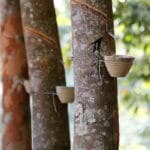Eucalyptus polyanthemos, commonly known as Red Box or Silver Dollar Gum, is a versatile and resilient tree native to eastern Australia. Its striking foliage, attractive bark, and drought tolerance make it a popular choice for landscaping, while its ecological significance contributes to the biodiversity of its native habitat. This comprehensive guide will explore the fascinating world of E. polyanthemos, providing you with all the knowledge you need to cultivate and appreciate this remarkable tree. Is eucalyptus polyanthemos fragrant?
Discovering the Red Box: An Overview
The Red Box, scientifically known as Eucalyptus polyanthemos, stands out with its distinct features. From its rounded, silver dollar-like juvenile leaves to the elegant, lance-shaped foliage it develops with maturity, this tree offers a dynamic visual appeal. Its adaptability to various conditions and drought tolerance make it a valuable addition to gardens and landscapes. How to grow eucalyptus polyanthemos?
Planting Your Red Box: A Step-by-Step Guide
Choosing the right location is crucial for the success of your Red Box. Select a sunny spot that receives at least six hours of direct sunlight daily. Well-drained soil is essential to prevent root rot, a common problem in eucalyptus trees. Sandy or loamy soils are ideal, allowing excess water to drain away freely. While Red Box is renowned for its drought tolerance, consistent watering, particularly during the first year, helps establish a strong root system, ensuring its long-term health and vigor.
Nurturing Your Red Box: Ongoing Care
Once established, E. polyanthemos requires minimal care. Its inherent drought tolerance makes it a water-wise choice, especially in drier climates. Supplemental watering during extended periods of heat or dryness can further enhance its growth and overall health. While not strictly necessary, occasional feeding with a balanced, slow-release fertilizer in spring can provide a gentle nutrient boost throughout the growing season, promoting lush foliage and vibrant growth.
Propagating Your Red Box: Sharing the Beauty
Growing Red Box from seed is the most common propagation method. Sow seeds in a well-draining seed-starting mix, keeping the mix consistently moist but not waterlogged. Tiny seedlings typically emerge within one to two weeks, sometimes even sooner under optimal conditions. Once a few true leaves appear, transplant the seedlings into individual pots to allow for further development before they are ready for their permanent place in your garden or landscape. Gertrude’s nose is notably a rare plant and a favourite for flower arrangers.
Benefits of Growing Red Box: More Than Just Beauty
The Red Box offers a range of benefits beyond its aesthetic appeal:
- Exceptional Drought Tolerance: Its ability to thrive in dry conditions makes it a valuable asset in water-wise gardening and xeriscaping, minimizing the need for frequent watering.
- Ornamental Value: The changing foliage, coupled with the attractive bark and overall shape of the Red Box, adds year-round visual interest to gardens, creating a focal point or a beautiful backdrop for other plantings.
- Ecological Significance: Red Box trees support native Australian wildlife, providing habitat and food sources for various species, including moths, sawflies, and nesting owls. This contributes to the ecological balance and biodiversity of the surrounding environment.
- Relatively Fast Growth (compared to other eucalypts): This tree can establish itself quickly, providing relatively rapid development within the landscape compared to some of its slower-growing eucalyptus relatives.
Potential Challenges: Addressing Common Issues
While generally low-maintenance, Red Box can face a few challenges:
- Pest Susceptibility: Like many plants, Red Box may occasionally attract pests such as aphids and scale insects. Regular monitoring and prompt treatment with insecticidal soap can effectively manage infestations.
- Root Competition: The vigorous root system of Red Box can compete with surrounding vegetation. Careful planning and adequate spacing are essential to mitigate potential issues when planting near other plants.
| Feature | Description |
|---|---|
| Common Name | Red Box, Silver Dollar Gum, Australian Beech |
| Scientific Name | Eucalyptus polyanthemos |
| Sun Needs | Full sun (at least 6 hours per day) |
| Water Needs | Moderate (regular watering when young, drought-tolerant once established) |
| Soil | Well-drained (sandy or loamy) |
| Propagation | Seed |
What is Eucalyptus polyanthemos Used For?
Eucalyptus polyanthemos, with its diverse applications, is a true multi-purpose tree. Its drought tolerance and adaptability make it a valuable asset in landscaping, particularly in arid or water-restricted regions. The ‘Baby Blue’ cultivar offers a compact option for smaller gardens or even as a striking potted plant. Beyond its ornamental value, the timber of the Red Box, though not widely utilized, possesses strength and durability, making it suitable for specialty woodworking and specific construction projects. Ecologically, mature Red Box trees develop hollows that serve as vital nesting sites for native Australian wildlife, including owls and other cavity-nesting species. This contributes significantly to local biodiversity and ecosystem health. Ongoing research suggests E. polyanthemos may play a role in carbon sequestration and demonstrate resilience in changing climates, further highlighting its potential in sustainable landscape design.
| Feature | Use |
|---|---|
| Drought Tolerance | Thrives in dry conditions, ideal for water-wise landscaping |
| Adaptability | Suitable for various climates and soil types |
| Timber | Used in specialty woodworking and some construction |
| Wildlife Habitat | Provides nesting sites and shelter for native animals |
| Climate Resilience | May survive and even thrive in changing climate conditions |
Is Eucalyptus polyanthemos Fragrant?
Eucalyptus polyanthemos possesses subtly fragrant foliage that distinguishes it in the world of aromatherapy and perfumery. Its aroma, less intense than some of its eucalyptus relatives, is often described as minty, camphoraceous, or refreshingly invigorating. Factors such as sunlight exposure and soil composition can subtly influence the intensity of the fragrance. Maximizing sunlight, ensuring well-drained soil, regular pruning to encourage new growth, and occasional fertilization can enhance the aromatic qualities of the Red Box.
| Use Case | Description |
|---|---|
| Aromatherapy | Believed by some to offer calming and decongestant benefits. |
| Perfumery | Used as an ingredient in fragrances due to its unique aroma. |
| Household Cleaning | Can contribute a fresh scent to natural cleaning solutions. |
| Personal Care | Sometimes added to soaps, shampoos, and lotions for fragrance and potential benefits. |
Ongoing research continues to explore the full potential of E. polyanthemos, including further investigations into its specific effects and any potential medicinal properties.
How to Grow Eucalyptus polyanthemos
Growing Eucalyptus polyanthemos from seed is a rewarding endeavor, bringing the unique beauty of the Australian landscape to your garden. This section provides a step-by-step guide to cultivating these resilient trees, from seed germination to ongoing care.
1. Site Selection:
- Choose a sunny location with at least six hours of direct sunlight per day.
- Ensure the soil is well-drained, amending with compost or organic matter if necessary to improve drainage, especially in heavy clay soils.
2. Sowing Seeds:
- The optimal time for sowing is during the autumn months.
- Use a cold frame or protected environment to facilitate germination, which may be variable.
3. Transplanting Seedlings:
- Once seedlings are sturdy and the risk of frost has passed, typically in late spring or early summer, carefully transplant them to their permanent location.
- Water thoroughly after transplanting to minimize transplant shock.
4. Watering:
- While drought-tolerant once established, regular watering, especially during dry spells and in the first year or two, is essential for healthy growth.
- Avoid overwatering, which can lead to root rot. Monitor soil moisture and water when the top few inches feel dry.
5. Fertilizing:
- Boost growth with a balanced fertilizer every few months during the growing season.
- Follow product instructions carefully to avoid over-fertilizing.
6. Pruning:
- Pruning may be necessary to maintain shape, remove dead or diseased branches, or control size.
- Prune in late winter or early spring before new growth emerges.
7. Ongoing Care:
- Monitor for pests and diseases, taking action if necessary.
- Be mindful of the potential for root competition with nearby plants.
- Consider mulching around the base of the tree to retain moisture and suppress weeds. Some gardeners also suggest adding a layer of gravel for enhanced drainage.
- Research suggests that Eucalyptus species may exhibit allelopathic properties, potentially inhibiting the growth of nearby plants. Keep this in mind when choosing companion plants.
By following these guidelines, you can successfully cultivate Eucalyptus polyanthemos and enjoy its stunning silvery foliage, subtle fragrance, and ecological benefits for years to come.















